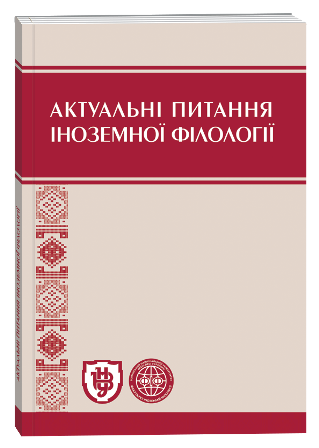STRUCTURAL PARAMETERS OF THE LEXICAL-SEMANTIC GROUP DECEPTION IN MODERN ENGLISH
DOI:
https://doi.org/10.32782/2410-0927-2022-17-5Keywords:
lexical-semantic group, structure, seme, interpretation, lexical units, dictionary articleAbstract
The scientific study is devoted to the analysis of the systematic arrangement of the lexical-semantic group of deception in the modern English language. The article defines the boundaries of non-linguistic reality, which are covered by the studied phenomenon in the linguistic consciousness of English speakers. This is a false perception of reality, caused by an incorrect, distorted reflection of it by the senses. An analysis of authoritative ideographic dictionaries of the English language was carried out, and three main meanings of the lexeme denoting deception in the English language were highlighted. As a result of the analysis of ideographic dictionaries and thesauruses of the English language, we singled out a group of lexemes “deception” united by the meaning “to convince anyone that something false is true, or to hide the truth from someone for one’s own benefit” was pointed out. We carried out the inventory of the lexical-semantic group according to a known procedure. This grouping includes lexical units in the interpretation of which the lexeme to deceive is found. Within this group of verbs, it seems possible to point out certain subgroups in which the lexical units are more closely related, united by a common seme. So, for example, we managed to point out predicates with the common seme “confuse, lead astray”, “persuade”, “deceive-trick”, “deceive-trick”, “deceive-deceive”, “deceive-forge”. The most numerous is the group of verbs with the seme “deceive-cheat”. In the English linguistic consciousness, to deceive is actualized as “behaving dishonestly, falsely, resorting to tricks”, as evidenced by the constituents of the studied group, which have the meaning – to pretend, to imitate, to play a double game, to distort. On the other hand, a dishonest person behaves carefully so as not to be exposed and not to scare away the “victim” of deception (to con, to stick, to chisel, to shave). The perspective of further research is the analysis of the metaphorical actualization of the studied extralinguistic phenomenon.
References
Великий тлумачний словник сучасної української мови. В. Т. Бусел (гол. ред.). Київ ; Ірпінь, 2005. VIII, 1728 с. URL: https: //sum.in.ua
Звегинцев В. А. Язык и лингвистическая теория. М. : Эдиториал УРСС, 2001. 248 с.
Канонік Н., Шкаровецька А. Наукові підходи до вивчення лексико-семантичних полів у лексико-семантичній системі сучасної української мови. Науковий вісник Східноєвропейського національного університету імені Л. Українки. 2015. С. 189–195.
Левицкий В. В. Статистическое изучение лексической семантики. Київ, 1989. 155 с.
Левицький В. В., Огуй О. Д., Кійко Ю. С., Кійко С. В. Апроксимативні методи вивчення лексичного складу. Чернівці : Рута, 2000. 136 с.
Лісовський П. М. Феномен маніпуляції свідомістю : сутність, структура, механізм у сучасному суспільстві (соціально-філософський аналіз) : автореф. дис. … канд. філос. наук : 09.00.03 «Соціальна філософія і філософія історії». Укр. держ. ун-т фінансів та міжнар. торгівлі. Київ, 2009. 20 с.
Микитенко А. Процес номінації у сучасній лінгвістиці: семасіологічний та ономасіологічний підходи. Актуальні питання гуманітарних наук. Вип. 21. 2018. С. 30–33.
Папуча М. В. Внутрішній світ людини та його становлення : наукова монографія. Ніжин, 2011. 656 с.
Поваренков Ю. П., Черноморец Е. Г. Ложь как объект философского и психологического анализа. Ярославский педагогический вестник. 2002. № 1. URL: http://vestnik.yspu.org/releases/pedagoka_i_psichologiy/13_6/
Семасиология / Изд. 2, исправл. и дополн. Винница : Нова Книга, 2012. 680 с.
Федірчик І. Я. Принципи виділення ядра лексико-семантичного поля найменувань осіб (на матеріалі іменників сучасної німецької мови). Науковий вісник ДДПУ імені І. Франка. Серія «Філологічні науки». Мовознаство. № 7, 2017. С. 207–2012.
Яремчук Р. А. Психологічна сутність категорій «неправда» та «брехня» в межах інтерпретації результатів поліграфічних досліджень. Юридична психологія. № 1 (28). 2021. С. 82–87.
Cambridge Dictionary. URL: http://dictionary.cambridge.org
Cambridge Idioms Dictionary (2006), (2nd ed.). Cambridge: Cambridge University Press.
Collins English dictionary. URL: https://www.collinsdictionary.com
A Dictionary of American Proverbs (n. d.). URL: https://books.google.com.ua/books?isbn=1469120933
The Free Dictionary by Farlex. URL: http://www.thefreedictionary.com
Macmillan English Dictionary. URL: http://www.macmillandictionary.com
McGraw-Hill. (2002). Dictionary of American Idioms and Phrasal Verbs. New York : The McGraw-Hill Companies, Inc. URL: http://english4success.ua
New Webster’s Dictionary and Thesaurus of the English Language. N.Y., 1993.
Oxford living dictionaries. Oxford University Press, 2020. URL: https://en.oxforddictionaries.com
The Random House Dictionary of the English Language. N.Y., 1990.
Roget’s Thesaurus of English Words and Phrases. London : Penguin Books, 2003. 712 p.







